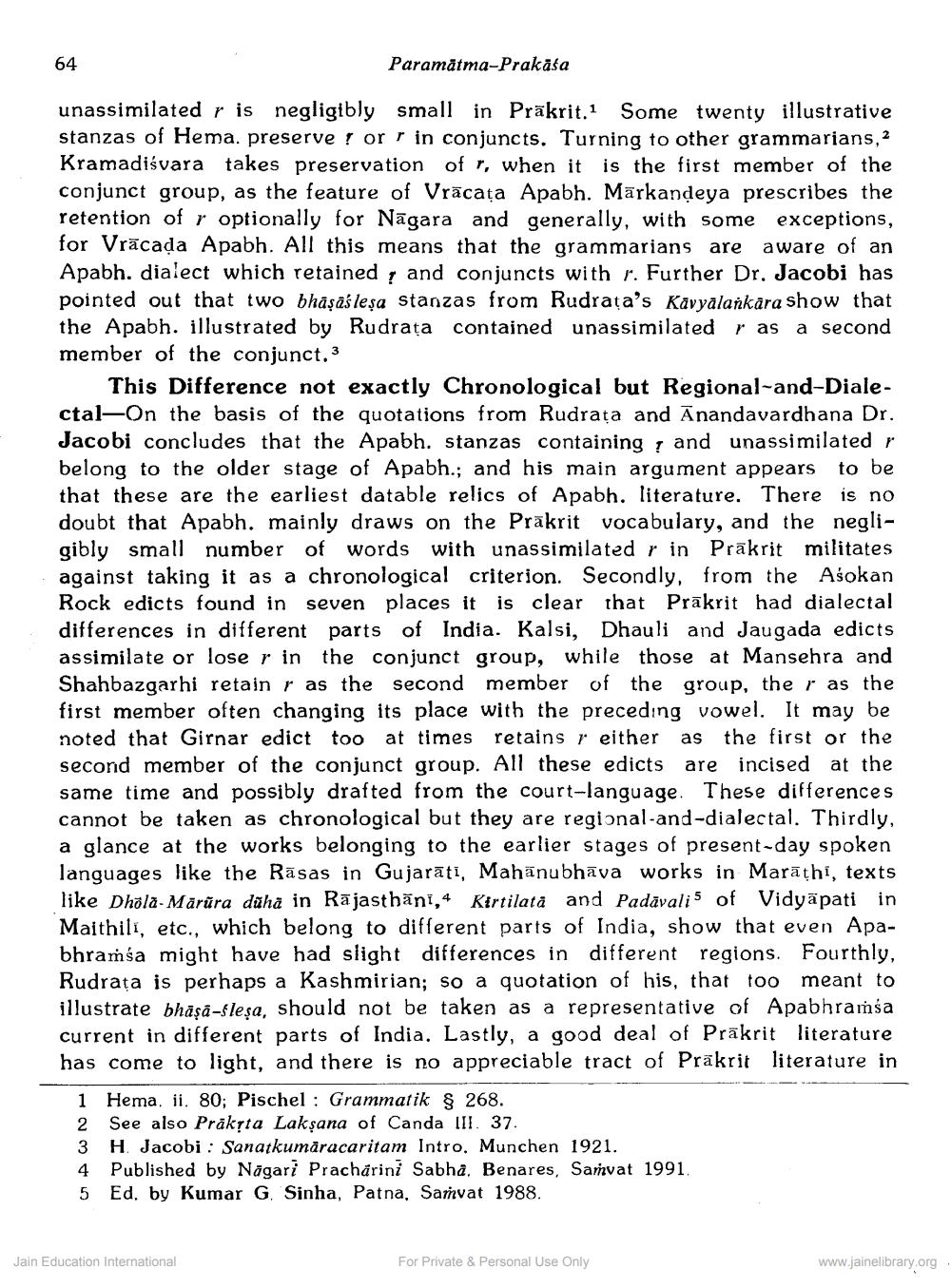________________
64
Paramātma-Prakasa
ice of Alle relics Prakrit
unassimilated r is negligibly small in Präkrit. Some twenty illustrative stanzas of Hema. preserve ! or r in conjuncts. Turning to other grammarians, 2 Kramadiśvara takes preservation of r, when it is the first member of the conjunct group, as the feature of Vrācata Apabh. Mārkandeya prescribes the retention of r optionally for Nagara and generally, with some exceptions, for Vrācada Apabh. All this means that the grammarians are aware of an Apabh. dialect which retained and conjuncts with r. Further Dr. Jacobi has pointed out that two bhāṣāšleșa stanzas from Rudrata's Kavyalankara show that the Apabh. illustrated by Rudrata contained unassimilated r as a second member of the conjunct.3
This Difference not exactly Chronological but Regional-and-Dialectal-On the basis of the quotations from Rudrata and Anandavardhana Dr. Jacobi concludes that the Apabh. stanzas containing , and unassimilated r belong to the older stage of Apabh.; and his main argument appears to be that these are the earliest datable relics of Apabh. literature. There is no doubt that Apabh. mainly draws on the Prakrit vocabulary, and the negligibly small number of words with unassimilated r in Prākrit militates against taking it as a chronological criterion. Secondly, from the Asokan Rock edicts found in seven places it is clear that Prakrit had dialectal differences in different parts of India. Kalsi, Dhauli and Jaugada edicts assimilate or lose r in the conjunct group, while those at Mansehra and Shahbazgarhi retain r as the second member of the group, the r as the first member often changing its place with the preceding vowel. It may be noted that Girnar edict too at times retains r either as the first or the second member of the conjunct group. All these edicts are incised at the same time and possibly drafted from the court-language. These differences cannot be taken as chronological but they are regional-and-dialectal. Thirdly, a glance at the works belonging to the earlier stages of present-day spoken languages like the Rāsas in Gujarāti, Mahānubhāva works in Marāthi, texts like Dhola- Mārūra dūha in Rajasthāni, 4 Kirtilata and Padāvalis of Vidyāpati in Maithili, etc., which belong to different parts of India, show that even Apabhramśa might have had slight differences in different regions. Fourthly, Rudrata is perhaps a Kashmirian; so a quotation of his, that too meant to illustrate bhāşå-sleșa, should not be taken as a representative of Apabhramsa current in different parts of India. Lastly, a good deal of Prakrit literature has come to light, and there is no appreciable tract of Prakrit literature in
1 Hema. ii. 80; Pischel : Grammatik § 268. 2 See also Praksta Laksana of Canda III. 37. 3 H Jacobi : Sanatkumāracaritam Intro. Munchen 1921. 4 Published by Nāgari Prachárini Sabha. Benares, Samvat 1991, 5 Ed. by Kumar G. Sinha, Patna, Samvat 1988.
Jain Education International
For Private & Personal Use Only
www.jainelibrary.org




